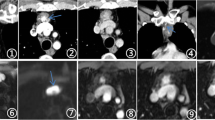Abstract
A contrast-enhanced mass was revealed by computed tomography and magnetic resonance imaging in the left pelvic cavity of a 71-year-old man. Although the mass appeared to be a cavernous hemangioma, malignancy could not be ruled out. Abdominal angiography was performed but failed to rule out malignancy because it revealed vascular dislocation and encasement. 18F-fluorodeoxyglucose positron emission tomography (FDG-PET) was then performed, and suggested a benign tumor, with a standardized uptake value (SUV) of 1.7. Following this finding, because the tumor was large and rupture could not be ruled out, we decided to perform surgery. The resected tumor was a benign cavernous hemangioma, consistent with the result obtained by FDG-PET.
Similar content being viewed by others
References
Hatayama K, Watanabe H, Ahmed AR, Yanagawa T, Shinozaki T, Oriuchi N, et al. Evaluation of hemangioma by positron emission tomography: role in a multimodality approach. J Comput Assist Tomogr 2003;27:70–77.
Hawnaur JM, Whitehouse RW, Jenkins JP, Isherwood I. Musculoskeletal haemangiomas: comparison of MRI with CT. Skeletal Radiol 1990;19:251–258.
Goldberg MA, Lee MJ, Fischman AJ, Mueller PR, Alpert NM, Thrall JH. Fluorodeoxyglucose PET of abdominal and pelvic neoplasms: potential role in oncologic imaging. Radiographics 1993;13:1047–1062.
Lindholm P, Leskinen-Kallio S, Grenman R, Lehikoinen P, Nagren K, Teras M, et al. Evaluation of response to radiotherapy in head and neck cancer by positron emission tomography and [11C]methionine. Int J Radiat Oncol Biol Phys 1995;32:787–794.
Kubota K, Yamada S, Ishiwata K, Ito M, Fujiwara T, Fukuda H, et al. Evaluation of the treatment response of lung cancer with positron emission tomography and L-[methyl-11C]methionine: a preliminary study. Eur J Nucl Med 1993;20:495–501.
Terhaard CH, Bongers V, van Rijk PP, Hordijk GJ. F-18-fluoro-deoxy-glucose positron-emission tomography scanning in detection of local recurrence after radiotherapy for laryngeal/pharyngeal cancer. Head Neck 2001;23:933–941.
Urakami T, Kondo K, Kasugai T, Sakakibara K, Nishiwaki M. A case of recurrent esophageal cavernous hemangioma increasing rapidly after surgery. Jpn J Thorac Cardiovasc Surg 1998;46:1206–1210.
Levine E, Wetzel LH, Neff JR. MR imaging and CT of extrahepatic cavernous hemangiomas. AJR Am J Roentgenol 1986;147:1299–1304.
Wetzel LH, Levine E. Soft-tissue tumors of the foot: value of MR imaging for specific diagnosis. AJR Am J Roentgenol 1990;155:1025–1030.
Crim JR, Seeger LL, Yao L, Chandnani V, Eckardt JJ. Diagnosis of soft-tissue masses with MR imaging: can benign masses be differentiated from malignant ones? Radiology 1992;185:581–586.
Levin DC, Gordon DH, McSweeney J. Arteriography of peripheral hemangiomas. Radiology 1976;121:625–630.
Mansour JC, Schwartz L, Pandit-Taskar N, D’Angelica M, Fong Y, Larson SM, et al. The utility of F-18 fluorodeoxyglucose whole body PET imaging for determining malignancy in cystic lesions of the pancreas. J Gastrointest Surg 2006;10:1354–1360.
Feldman F, van Heertum R, Manos C. 18FDG-PET scanning of benign and malignant musculoskeletal lesions. Skeletal Radiol 2003;32:201–208.
Aoki J, Watanabe H, Shinozaki T, Takagishi K, Tokunaga M, Koyama Y, et al. FDG-PET for preoperative differential diagnosis between benign and malignant soft tissue masses. Skeletal Radiol 2003;32:133–138.
Mergo PJ, Ros PR. Benign lesions of the liver. Radiol Clin North Am 1998;36:319–331.
Ericson K, von Holst H, Mosskin M, Bergstrom M, Lindqvist M, Noren G, et al. Positron emission tomography of cavernous haemangiomas of the brain. Acta Radiol Diagn (Stockh) 1986;27:379–383.
Hara M, Lida A, Tohyama J, Miura N, Shiraki N, Itoh M, et al. FDG-PET findings in sclerosing hemangioma of the lung: a case report. Radiat Med 2001;19:215–218.
Hirai K, Umesaki N, Sumi T, Ishiko O, Kanaoka Y, Ogita S, et al. Combined diagnostic imaging for retroperitoneal schwannoma. Oncol Rep 2001;8:773–775.
Hamada K, Ueda T, Higuchi I, Inoue A, Tamai N, Myoi A, et al. Peripheral nerve schwannoma: two cases exhibiting increased FDG uptake in early and delayed PET imaging. Skeletal Radiol 2005;34:52–57.
Author information
Authors and Affiliations
Corresponding author
Rights and permissions
About this article
Cite this article
Higashiyama, S., Kawabe, J., Hayashi, T. et al. A case of cavernous hemangioma in which malignancy was preoperatively excluded by FDG-PET. Ann Nucl Med 22, 327–330 (2008). https://doi.org/10.1007/s12149-007-0101-4
Received:
Accepted:
Published:
Issue Date:
DOI: https://doi.org/10.1007/s12149-007-0101-4




